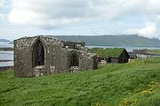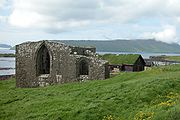
Ancient Diocese of the Faroe Islands
Encyclopedia
The former Catholic Diocese of the Faroe Islands existed from the eleventh century to the Protestant Reformation
. The Faroe Islands
are now included in the Roman Catholic Diocese of Copenhagen.
 As recorded in the Færeyinga Saga
As recorded in the Færeyinga Saga
, Sigmundur Brestisson
came to the Faroes and converted the people
to Christianity
more or less one by one. He was eventually attacked at his home by his first (forced) convert, Tróndur í Gøtu
, swam to another island to escape, and was finally killed by a farmer for his gold jewelry.
There is some confusion as to when the first bishop for the islands was consecrated, as Adam of Bremen
notes that a self-proclaimed bishop of Helgoland was referred to in Latin as the bishop of "Farria."
The bishops of the Faroe Islands were usually chosen from the canons of the Diocese of Bergen and were originally suffragans of the Archdiocese of Hamburg-Bremen. The diocese was granted to Lund in 1104 and then Nidaros
after 1152. The see was based at Kirkjubøur
, which legend holds was given to Bishop Orm by Gæsa Sigursdottir as a penance for her having eaten meat during Lent
. Some of the bishops are known to have kept mistresses, and it was reported that clergy in the Faroes would on occasion demand prima nocte
rights.
Amund Olafson was the last Roman Catholic bishop of the islands and was forced to yield his see and title to the Lutheran superintendent
Jens Riber. Later, only "provosts" were elected. The Catholic clergy were unable to resist the advance of Lutheranism
. By the end of sixteenth century, the Catholic faith had disappeared.
In the Catholic epa, at least, no little attention paid to the construction and adornment of churches, as may be seen from the ruins of the unfinished Magnus Cathedral
of Kirkjubøur
. The thick basaltic walls broken by high, massive windows are evidence that the original builders meant to erect a Gothic church. It remained unfinished.
Protestant Reformation
The Protestant Reformation was a 16th-century split within Western Christianity initiated by Martin Luther, John Calvin and other early Protestants. The efforts of the self-described "reformers", who objected to the doctrines, rituals and ecclesiastical structure of the Roman Catholic Church, led...
. The Faroe Islands
Faroe Islands
The Faroe Islands are an island group situated between the Norwegian Sea and the North Atlantic Ocean, approximately halfway between Scotland and Iceland. The Faroe Islands are a self-governing territory within the Kingdom of Denmark, along with Denmark proper and Greenland...
are now included in the Roman Catholic Diocese of Copenhagen.
History

Færeyinga Saga
The Færeyinga Saga , the Norse saga of Faroemen, is the story of how the Faroes were converted to Christianity and became a part of the Kingdom of Norway.-Summary:It was written in Iceland shortly after 1200...
, Sigmundur Brestisson
Sigmundur Brestisson
Sigmundur Brestisson introduced Christianity to the Faroe Islands in 999. He is one of the main characters of the Færeyinga saga.According to the Færeyinga Saga, emigrants who left Norway to escape the tyranny of Harald I of Norway, settled in the islands about the beginning of the 9th century...
came to the Faroes and converted the people
Faroese people
The Faroese or Faroe Islanders are a Germanic ethnic group native to the Faeroe Islands. The Faroese are of mixed Norse and Gaelic origins.About 21,000 Faroese live in neighbouring countries, particularly in Denmark, Iceland and Norway....
to Christianity
Christianity
Christianity is a monotheistic religion based on the life and teachings of Jesus as presented in canonical gospels and other New Testament writings...
more or less one by one. He was eventually attacked at his home by his first (forced) convert, Tróndur í Gøtu
Tróndur í Gøtu
Tróndur í Gøtu was a viking from the Faroe Islands . He and Sigmundur Brestisson are the central figures in the Færeyinga Saga, which tells the early history of the Faroe Islands and the coming of Christianity to the islands, which Tróndur opposed.Chapter 3 of the Saga describes Tróndur as...
, swam to another island to escape, and was finally killed by a farmer for his gold jewelry.
There is some confusion as to when the first bishop for the islands was consecrated, as Adam of Bremen
Adam of Bremen
Adam of Bremen was a German medieval chronicler. He lived and worked in the second half of the eleventh century. He is most famous for his chronicle Gesta Hammaburgensis Ecclesiae Pontificum .-Background:Little is known of his life other than hints from his own chronicles...
notes that a self-proclaimed bishop of Helgoland was referred to in Latin as the bishop of "Farria."
The bishops of the Faroe Islands were usually chosen from the canons of the Diocese of Bergen and were originally suffragans of the Archdiocese of Hamburg-Bremen. The diocese was granted to Lund in 1104 and then Nidaros
Archdiocese of Nidaros
The Archdiocese of Nidaros was the metropolitan see covering Norway in the later Middle Ages. The see was the Nidaros Cathedral, in the city of Nidaros...
after 1152. The see was based at Kirkjubøur
Kirkjubøur
Kirkjubøur is the southernmost village on Streymoy, Faroe Islands and the country's most important historical site.It is located on the west coast and has a view towards the islands Hestur and Koltur.-History:...
, which legend holds was given to Bishop Orm by Gæsa Sigursdottir as a penance for her having eaten meat during Lent
Lent
In the Christian tradition, Lent is the period of the liturgical year from Ash Wednesday to Easter. The traditional purpose of Lent is the preparation of the believer – through prayer, repentance, almsgiving and self-denial – for the annual commemoration during Holy Week of the Death and...
. Some of the bishops are known to have kept mistresses, and it was reported that clergy in the Faroes would on occasion demand prima nocte
Droit de seigneur
Droit du seigneur is an alleged legal right allowing the lord of a medieval estate to take the virginity of his serfs' maiden daughters. There is no historical evidence that such a right ever existed.-Terminology:...
rights.
Amund Olafson was the last Roman Catholic bishop of the islands and was forced to yield his see and title to the Lutheran superintendent
Superintendent (ecclesiastical)
Superintendent is the head of an administrative division of a Protestant church, largely historical but still in use in Germany.- Superintendents in Sweden :...
Jens Riber. Later, only "provosts" were elected. The Catholic clergy were unable to resist the advance of Lutheranism
Lutheranism
Lutheranism is a major branch of Western Christianity that identifies with the theology of Martin Luther, a German reformer. Luther's efforts to reform the theology and practice of the church launched the Protestant Reformation...
. By the end of sixteenth century, the Catholic faith had disappeared.
In the Catholic epa, at least, no little attention paid to the construction and adornment of churches, as may be seen from the ruins of the unfinished Magnus Cathedral
Magnus Cathedral
Magnus Cathedral is a ruined cathedral in the town of Kirkjubøur in the Faroe Islands. It was built in by Bishop Erlendur about the year 1300, but the building was never completed. The cathedral is to this day in an unfinished state; the building has never had a roof. Magnus Cathedral is the...
of Kirkjubøur
Kirkjubøur
Kirkjubøur is the southernmost village on Streymoy, Faroe Islands and the country's most important historical site.It is located on the west coast and has a view towards the islands Hestur and Koltur.-History:...
. The thick basaltic walls broken by high, massive windows are evidence that the original builders meant to erect a Gothic church. It remained unfinished.
List of the Bishops of the Faroe Islands
- 1047-1067 - Bernhard Sakseren, missionary bishop
- Late 11th c. - Ryngerus, missionary bishop
- c. 1100-1137 - Gudmund
- 1138-? - Orm, acquired KirkjubøurKirkjubøurKirkjubøur is the southernmost village on Streymoy, Faroe Islands and the country's most important historical site.It is located on the west coast and has a view towards the islands Hestur and Koltur.-History:...
- ?-1157 - Matthew I or Martin I
- 1158-1162 - vacant
- 1162-1174 - Roe, taught Sverre SigurdssonSverre of NorwaySverre Sigurdsson was king of Norway from 1177 to 1202. He married Margareta Eriksdotter, the daughter of the Swedish king Eric the Saint, by whom he had the daughter Kristina Sverresdotter....
, king of Norway after 1184 - ?-1212 - Sven
- (1213)-1214 - Olaf
- 1215 - vacant
- 1216-(1237) - Serquirus or Sverker
- ?-1243 - Bergsven
- c. 1245 - Nicholas, doubtful
- 1246-1257 - Peter
- 1258-1260/61 - vacant
- 1261/62-1268 - Gaute
- 1269-1308 - Erlandr, expanded church holdings throughout the islands
- 1309-1312 - vacant
- (1313)-1316 - Lodin of Borgund
- 1317-1319 - vacant
- 1320-? - Signar
- ? - Gevard
- 1343-1348 - Håvard
- (1349) - vacant
- (1350)-1359 - Arne I
- 1359-1369 - Arne II Svæla
- ? - Andrew, elected, but likely unconsecrated
- ? - Arnold, doubtful
- (1381) - Richard
- 1385-? - William Northbrigg
- (?) - Vigbold or Vigbald
- 1391 - Philip Gudbrandsson of Nidaros, elected, but likely unconsecrated
- (1392) - Halgier, likely unconsecrated
- 1408-(1430) - Jon I the German
- 1432-1434 - Severinus, also bishop of Tranquilia
- (1434) - Jon II the Dominican
- 1434-(?) - Jon III the Chief
- (1441/42-1451) - Hemming
- (1452–1453) - vacant
- (1453-?) - Jon IV
- ? - Matthew II or Martin II
- ? - Hilary, questionable
- (?)-(1532) - Chilianus
- (1532–1538) - Ámundur Ólavsson (Amund), last Catholic bishop, ordered by Christian IIIChristian III of DenmarkChristian III reigned as king of Denmark and Norway. He was the eldest son of King Frederick I and Anna of Brandenburg.-Childhood:...
to leave his mistress - 1540-1556 - Jens Riber, Lutheran, last bishop
See also
- Roman Catholicism in the Faroe IslandsRoman Catholicism in the Faroe IslandsThe history of Roman Catholic Church in the Faroe Islands goes back to the year 999, when king Olav Tryggvason of Norway sent Sigmundur Brestisson on a mission to the islands with several priests. The islands became an independent diocese in 1111, but were officially reformed in 1537 and the last...
- The Protestant Church of the Faroe IslandsChurch of the Faroe IslandsThe Church of the Faroe Islands was a diocese of the Lutheran Church of Denmark until it became independent on 29 July 2007, as the smallest of the world's few remaining state churches....

